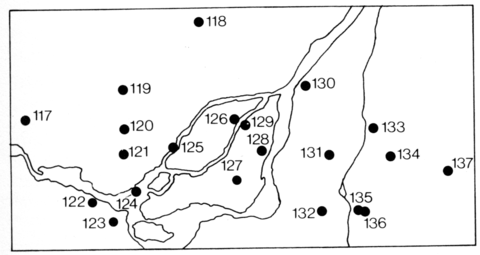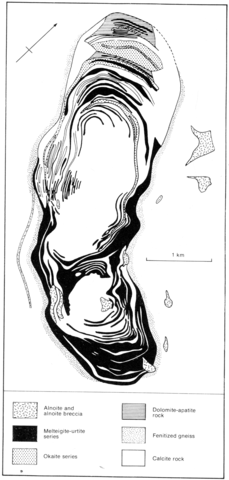stripes
The Oka Hills rise to 215 m above the St Lawrence Lowlands and represent an inlier of some 115 km2 of Precambrian gneisses surrounded by Palaeozoic sedimentary rocks. The Oka complex underlies an oval-shaped depression in the southeastern part of the hills, and is extensively covered by glacial deposits and sediments, locally 60-120 m thick, laid down in the pro-glacial Champlain Sea. Although badly exposed, detailed maps are available as a result of mining activities and an extensive drilling programme which has produced at least 69 000 m of core. The complex consists essentially of two adjacent centres of concentric ring dykes or cone sheets. In the more southerly centre dips are everywhere outwards and increase towards the margin, whereas in the larger more northerly centre inward dips are prevalent towards the centre and outward dips nearer the margins. The central parts of both the northern and southern centres are essentially carbonatitic around which are alternating sheets of carbonatite and various types of alkaline silicate rocks. Late lamprophyric dykes and breccia pipes cut both the central complex and the country rocks. Gold (1972, Table 1) has divided the rocks of Oka into five main groups: (1) Carbonate rocks. These underlie about half the complex and Gold lists 12 mineralogical variants, one of which, rauhaugite, is confined to the northern end of the complex; the rest involve calcite plus various combinations of sodic pyroxene, biotite, apatite, nepheline, monticellite, melilite, pyrochlore, perovskite, niocalite, richterite, pyrite and pyrrhotine. These rocks are layered with a foliation defined by concentrations of ferromagnesian minerals and magnetite 1-5 cm thick and 5-30 cm apart. (2) Okaite-jacupirangite series. These are essentially melilitites and pyroxenites and occur only in the northern ring. They vary from okaite consisting of melilite (60- 90%), nepheline (10-40%) and accessory hauyne, perovskite, apatite, biotite, magnetite and calcite, through nepheline and hauyne okaite and titanian-augite-bearing okaite to nepheline jacupirangite and jacupirangite (60-70% Ti-augite, 15-20% nepheline, 2-10% magnetite, apatite, biotite and perovskite). (3) Ijolite series. These vary from urtites and wollastonite urtites through ijolites, including melanite, calcite and wollastonite-bearing varieties, to melteigites and calcite melteigites. In the inner parts of the complex ijolites predominate but near the margins urtites and juvites are abundant and the relict textures and heterogeneity indicate these may be ultra-fenites. (4) Lamprophyres and breccias. Lamprophyre dykes are principally alnoites, minettes and biotite fourchites. Breccia pipes may be polymict breccias of country rocks in an alnoitic matrix, massive alnoite or carbonatitic breccias. (5) Metasomatic rocks. There is a discontinuous and badly exposed fenite aureole around the complex and glimmerites occur in zones within and cutting across the main units of the intrusion. For rock analyses and petrogenetic discussion see Gold (1972) and references cited therein. Treiman and Essene (1984) have described a periclase-dolomite-calcite carbonatite for which the volatile composition could be calculated. The list of minerals identified from Oka is extensive. Gold (1972, Table 2) cites 76 including many rare and unusual species and considerable mineralogical data are given in Gold (1966). Published papers on Oka are numerous and aspects investigated include carbon and oxygen isotopic ratios in coexisting minerals (Conway and Taylor, 1969) and in carbonates (Deines, 1970); Pb isotopes (Grunenfelder et al., 1982); sulphur isotopes (Mitchell and Krouse, 1975); REE and yttrium (Eby, 1975) and Sc (Eby, 1973) in rocks and minerals; evolution of zoned micas and associated pyroxenes, amphiboles and carbonates (Rimsaite, 1969); magnetite and pyrochlore chemistry (McMahon and Haggerty, 1979); experimental studies bearing on petrogenesis and Nb mineralization (Watkinson, 1970) and oxygen fugacity geothermometry (Friel and Ulmer, 1974).
CONWAY, C.M. and TAYLOR, H.P. 1969. O18/O16 and C13/C12 ratios of coexisting minerals in the Oka and Magnet Cove carbonatite bodies. Journal of Geology, 77: 618-26.
DEINES, P. 1970. The carbon and oxygen isotopic composition of carbonates from the Oka carbonatite complex, Quebec, Canada. Geochimica et Cosmochimica Acta, 37: 1199-225.
EBY, G.N. 1973. Scandium geochemistry of the Oka carbonatite complex, Oka, Quebec. American Mineralogist, 58: 819-25.
EBY, G.N. 1975. Abundance and distribution of the rare-earth elements and yttrium in the rocks and minerals of the Oka carbonatite complex, Quebec. Geochimica et Cosmochimica Acta, 39: 597-620.
FAIRBAIRN, H.W., FAURE, G., PINSON, W.H., HURLEY, P.M. and POWELL, J.L. 1963. Initial ratio of strontium 87 to strontium 86, whole- rock age, and discordant biotite in the Monteregian igneous province, Quebec. Journal of Geophysical Research, 68: 6515-22.
FRIEL, J.J. and ULMER, G.C. 1974. Oxygen fugacity geothermometry of the Oka carbonatite. American Mineralogist, 59: 314-8.
GOLD, D.P. 1966. The minerals of the Oka carbonatite and alkaline complex, Oka, Quebec. International Mineralogical Association, Papers and Proceedings of the Fourth General Meeting, New Delhi: 109-25.
GOLD, D.P. 1972. The Monteregian Hills: ultra-alkaline rocks and the Oka carbonatite complex. 24th International Geological Congress, Excursion Guide, B-11: 1-47.
GOLD, D.P., VALLEE, M. and CHARETTE, J.P. 1967. Economic geology and geophysics of the Oka alkaline complex, Quebec. Canadian Mining and Metallurgy Bulletin, 60: 1131-44.
GRUNENFELDER, M.H., TILTON, G.R., BELL, K. and BLENKINSOP, J. 1982. Lead isotope relationships in the Oka carbonatite complex, Quebec (Abstract). EOS, Transactions, American Geophysical Union, 63: 1134.
MCMAHON, B.M. and HAGGERTY, S.E. 1979. The Oka carbonatite complex: magnetite compositions and the related role of titanium in pyrochlore. In Proceedings of the Second International Kimberlite Conference (Eds F.R. Boyd and H.O.A. Meyer), 1: 382-92.
MITCHELL, R.H. and KROUSE, H.R. 1975. Sulphur isotope geochemistry of carbonatites. Geochimica et Cosmochimica Acta, 39: 1505-13.
RIMSAITE, J. 1969. Evolution of zoned micas and associated silicates in the Oka carbonatite. Contributions to Mineralogy and Petrology, 23: 340-60.
SHAFIQULLAH, M., TUPPER, W.M. and COLE, T.J.S. 1970. K-Ar age of the carbonatite complex, Oka, Quebec. Canadian Mineralogist, 10: 541-52.
TREIMAN, A.H. and ESSENE, E.J. 1984. A periclase-dolomite-calcite carbonatite from the Oka complex, Quebec, and its calculated volatile composition. Contributions to Mineralogy and Petrology, 85: 149-57.
WATKINSON, D.H. 1970. Experimental studies bearing on the origin of the alkalic rock-carbonatite complex and niobium mineralization at Oka, Quebec. Canadian Mineralogist, 10: 350-61.


